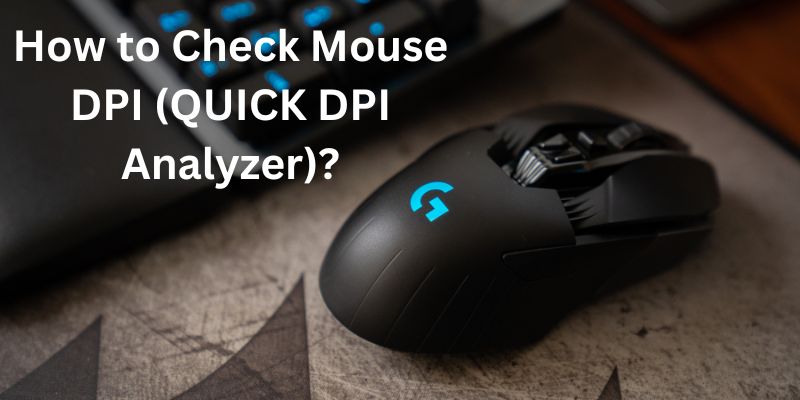In the ever-evolving world of gaming and productivity, having precise control over your mouse cursor is crucial. Your mouse’s DPI (Dots Per Inch) setting plays a pivotal role in determining how fast or slow your cursor moves across the screen. Whether you are a gamer looking to fine-tune your aiming accuracy or a professional seeking pixel-perfect precision, knowing how to check mouse DPI is essential.
What is Mouse DPI?
DPI, or Dots Per Inch, is a measurement of how sensitive your mouse is. It determines how many pixels your cursor will move on the screen when you move your mouse one inch. Higher DPI settings result in faster cursor movement, while lower DPI settings lead to slower cursor movement. Knowing your mouse’s DPI allows you to tailor its sensitivity to your specific needs.
Methods to Check Mouse DPI (QUICK DPI Analyzer)
Method 1: Use the QUICK DPI Analyzer Tool
In 2023, QUICK DPI Analyzer has become a popular and reliable tool for checking your mouse’s DPI. Follow these steps to use it effectively:
- Open your preferred web browser and navigate to the QUICK DPI Analyzer website. You can easily find it through a quick Google search.
- Make sure your mouse is properly connected to your computer. A wired connection is recommended for the most accurate results.
- Once on the website, look for the DPI Analyzer tool. It’s usually prominently featured on the homepage. Click on it to start the process.
- The DPI Analyzer tool will guide you. Typically, it will ask you to move your mouse a certain distance on a designated area of your mouse pad. Follow these instructions carefully.
- After completing the required movements, the tool will display your mouse’s DPI on the screen. Make a note of this value for future reference.
Method 2: Check Mouse DPI Using Manufacturer Software
Many mouse manufacturers provide dedicated software that allows you to customize and check your mouse’s DPI settings. Follow these steps:
- Visit the official website of your mouse manufacturer and download their software. Install it on your computer.
- Launch the manufacturer’s software and connect your mouse to it.
- Look for the DPI settings within the software. It may be under the “Settings,” “Sensitivity,” or a similar tab.
- In the DPI settings, you’ll find your current DPI setting displayed. Take note of this value.
Method 3: Check DPI Through Windows Settings
Windows also offers a way to check your mouse’s DPI without the need for additional software. Here’s how:
- Right-click on the Windows Start button and select “Settings.” In the Settings window, click on “Devices.”
- In the Devices menu, select “Mouse” from the left-hand sidebar.
- Scroll down and click on “Additional mouse options” under Related settings.
- In the Mouse Properties window, go to the “Pointer Options” tab. You will see a slider under “Select a pointer speed.” This slider represents your current DPI setting. Take note of its position.
Method 4: Check DPI Using Online Calculators
Online DPI calculators are another convenient way to determine your mouse’s DPI. Here’s how:
- Launch your preferred web browser.
- Perform a quick search for “DPI calculator” using your preferred search engine.
- Select a reputable DPI calculator website from the search results. Websites like Mouse-Sensitivity.com or DPI Analyzer are good choices.
- Once on the chosen website, you’ll typically find instructions on how to measure your mouse’s DPI. This may involve measuring the distance your cursor moves when you move your mouse a specific distance on your mousepad. Follow these instructions carefully.
- After following the instructions, the calculator will display your mouse’s DPI value. Make a note of this value.
Method 5: Check DPI Using In-Game Settings
Many modern games provide an option to view and adjust your mouse DPI within the game settings. Here’s how:
- Start the game for which you want to check or adjust your mouse DPI.
- Inside the game, go to the settings menu. The location of this option may vary depending on the game, but it’s typically found in the main menu or the pause menu.
- Look for a section related to mouse settings or input settings. It might be labeled as “Mouse Sensitivity” or something similar.
- In this section, you will often find an option to view or adjust your mouse DPI. Check to see if your current DPI setting is displayed. If not, you may be able to adjust it here and note the value.
Method 6: Check DPI Using Manufacturer Documentation
If you have the original packaging or documentation that came with your mouse, you can often find information about its DPI there. Here’s how:
- Find the user manual, box, or any documentation that came with your mouse.
- Look for a section that provides technical specifications for your mouse. This section should include details about the mouse’s DPI setting.
- Once you have located the DPI specification, make a note of the DPI value specified in the documentation.
Conclusion
Knowing your mouse’s DPI is crucial for achieving optimal control and accuracy in both gaming and productivity tasks. In 2023, using the QUICK DPI Analyzer tool is a quick and reliable method to check your mouse’s DPI. Additionally, you can explore your mouse manufacturer’s software or utilize Windows settings to access this information. With this knowledge, you can fine-tune your mouse sensitivity to suit your needs and dominate your digital endeavors.
You may also like:
Factors to Consider Before Buying a Gaming Mouse
FAQs
Q:- What is the ideal DPI setting for gaming?
Ans:- The ideal DPI setting for gaming varies from person to person and depends on individual preferences and the type of games played. Many gamers prefer DPI settings between 800 and 1600 for first-person shooters, as it provides a good balance of accuracy and responsiveness. However, it’s essential to experiment and find a DPI setting that feels comfortable for you.
Q:- Can I change my mouse’s DPI?
Ans:- Yes, most modern gaming mice and some regular mice allow you to adjust the DPI settings. You can usually do this through manufacturer software or in-game settings. Customizing your DPI can help you find the sensitivity that suits your needs best.
Q:- What if I don’t have access to the internet to use online DPI calculators?
Ans:- If you don’t have access to the internet, you can check your mouse’s DPI using manufacturer software, Windows settings, or in-game settings, as described in the article. These methods do not require an internet connection.
Q:- Does a higher DPI setting mean better accuracy?
Ans:- Not necessarily. While a higher DPI setting can provide faster cursor movement, it doesn’t necessarily equate to better accuracy. Achieving accuracy depends on your comfort and control with your chosen DPI setting. Some gamers prefer lower DPI settings for precise aiming, while others prefer higher DPI for quicker cursor movements.
Q:- What if I can’t find my mouse’s DPI in the manufacturer’s documentation or software?
Ans:- If you can’t find your mouse’s DPI in the documentation or software, you can use an online DPI calculator or the QUICK DPI Analyzer tool as described in the article. These tools can measure your mouse’s DPI without relying on manufacturer-provided information.







